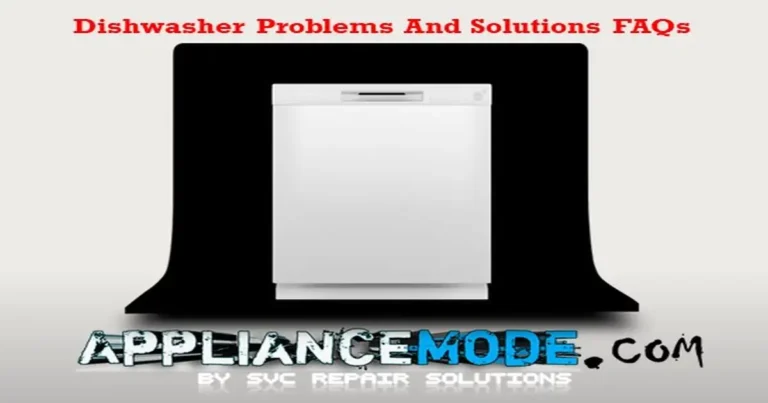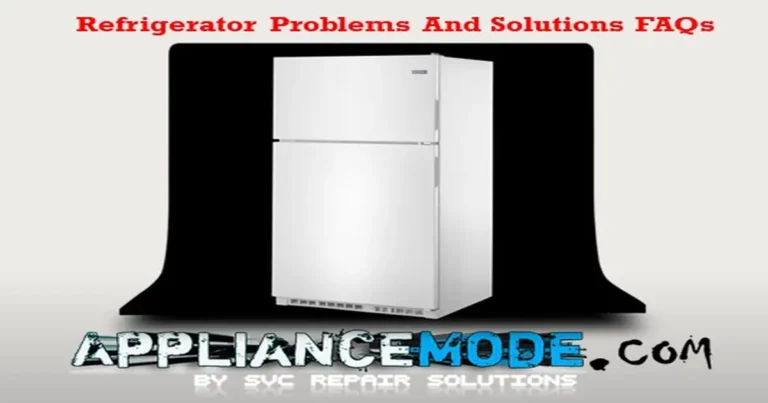Washing machines make household chores easier and are a crucial aspect of our daily lives. However, like all appliances, washing machines can also experience problems from time to time. In this article, we will discuss some of the most frequently asked questions (FAQs) about washing machine problems and solutions to help you troubleshoot and resolve them.

From issues with the machine not turning on to problems with its performance, this comprehensive guide will provide you with the information and knowledge you need to keep your washing machine running smoothly.
Washing machine problems and solutions: Diagnostic and Troubleshooting Guide Q&A
There could be several reasons why your washing machine doesn’t have power, such as:
1. The washer is not switched on.
2: The power cord is unplugged.
3: The wall outlet doesn’t have power.
4: The internal safety fuses have melted.
To troubleshoot, try switching on the washer, plugging the power cord directly into a wall outlet, checking and activating the main power fuse, unplugging the washer and using another working device to check the wall outlet, or checking the power assembly and internal safety fuse.
The power cutoff after starting could be caused by:
1: An underdimensioned power group.
2: A faulty power extension block.
3: Too much power consumption in the same power group.
4: A shortcut in the washing machine.
5: A faulty main PCB.
To troubleshoot, check if the washing machine is connected to the correct power group, avoid using an extension block, check if multiple appliances are sharing the same power group, unplug the washer and use another working device to check the wall outlet, and check the heater and main PCB.
Water leakages in a washing machine could be caused by:
1: Leakages at the drain hose, inlet hose(s) or connections, or around the door, dispenser drawer, or drain pump filter housing.
To troubleshoot, check the height of the standpipe, check for kinked or restricted drain hose, check the inlet hose for loose connections or cuts, check the door gasket for damage and dirt, check the dispenser tray and drawer for damages, check the complete water path for leakages, and ensure proper placement of the hoses and gaskets. Check the back of the tub for rust due to leaking along the bearing.
This might be caused by clothes remaining in the drum after the cycle is finished, insufficient pumping action, or a defective drain pump. To reduce the odor, it’s recommended to wash towels and bed linen at 60°C and use less detergent. Here are a few solutions to try:
1. Remove the clothes as soon as the cycle is finished, and leave the door open for ventilation.
2: Check and clean the dispenser tray and ensure there is no contamination in the dispenser box.
3. Clean the pump filter and ensure proper drainage.
4: Check the water hoses connecting the dispenser drawer and the outer tub for detergent residue and clean them.
5: Check and clean the tub and gasket.
6: You can also run a 90°C cycle with a dishwasher tablet to clean the tub assembly. Do not use bleach!
This might be caused by friction at the gasket, an overloaded motor, a new electronic board just installed, or overheated parts. Here are a few solutions to try:
1- Check the distance between the drum and gasket and ensure it’s not too small.
2- Open the door and check the drum by turning it manually.
3- Check if the display does not light up when the drum is rotating.
4- Check if the electronic assemblies have been recently installed. When the new electronic components become warm for the first time, the smell should normally disappear after approximately 2–3 days.
5- Check the power connections and assemblies.
6- Ensure the connectors in the assemblies are fully inserted.
7- Check the water level and ensure the heater is submerged.
If your washing machine display lights up but it’s not starting, it might be caused by the “Child Lock” or “Delay” being enabled, an open door, or a problem with the water supply. Here are a few solutions to try:
1- Check the main power supply to the washing machine, wall outlet, and house safety switch.
2- Deactivate the “Child Lock” or “Delay” as described in the user manual.
3- Ensure the door is completely closed.
4- Check that the water tap is not frozen, clogged, or closed.
5- Check the inlet hose for proper water flow.
6- Check and clean the inlet filter.
7- Check the water inlet valve.
8- Ensure the standpipe height does not exceed the maximum height of 1 m.
9- Check for a kinked or restricted drain hose, pipe, or utility sink.
10- Ensure the dispenser is not overfilled with detergent.
11- Check the load distribution across the drum surface.
12- Clean the pump filter and ensure proper drain.
13- Check the power connections and assemblies.
14- Check the door lock assembly.
15- Check the bellows, hoses, filter, and drain pump.
16- Check the main PCB.
Possible causes include a faulty motor, hall sensor, or main board. To troubleshoot, drain the machine using the spin-only option, unplug the machine, and check if the drum can rotate freely with normal force. If you hear an abnormal noise, check the bearing. Check the hall sensor, stator assembly, and rotor assembly for broken or loose magnets. If the display or LED on the main PCB isn’t working, replace the main PCB.
The issue could be due to the inside drum temperature being too high or a faulty steam generator. Check the steam generator to resolve the issue.
Possible causes include a closed, clogged, or frozen water tap, a kinked inlet hose, a clogged water inlet valve, or a faulty main PCB. Check the water tap, inlet hose, inlet filter, and water inlet valve. Clean up any residue and check the main PCB to resolve the issue.
Possible causes include an overloaded washing machine, a clogged pump filter, a faulty water inlet valve, a faulty drying assembly (drying fan, heater, high limit, etc.), or a faulty main PCB. Choose the ‘Auto-dry’ program, connect the machine to the cold water tap because warm water reduces the performance of condensation and the moisture cannot be removed, and check the inlet hose, inlet filter, pump filter, water inlet valve, drying assembly, and main PCB.
Possible causes include a tangled or unevenly distributed load, a small load, an unleveled washing machine, too much detergent, a faulty hall sensor, or a clogged detergent box assembly. Check the load distribution, machine leveling, dispenser (for too much detergent), hall sensor, and detergent box assembly.
Possible causes include a tangled or unevenly distributed load, a small load, an unleveled washing machine, or a faulty hall sensor. Check the load distribution, machine leveling, and hall sensor to resolve the issue.
There could be several reasons, including too much softener, a clogged dispenser, a faulty water inlet valve, or a faulty main PCB. To troubleshoot, check the softener level in the detergent tray, clean the dispenser tray, and check for any contamination. Only liquid softener can be used in this type of dispenser, and powder softener should be added manually to the drum. Check the correct activation of the water inlet valves and observe if the water sprays in the main and pre-wash compartments. Finally, check the main PCB.
There could be several reasons, including leaving clothes in the drum for too long, a program with low spin speed, a single big item loaded, water not draining, excessive foam, excessive fabric softener, or a faulty DD motor or main PCB. To troubleshoot, remove the laundry as soon as possible after washing, select a program with a higher spin speed, redistribute the load or add more similar items, check the standpipe height, check for a kinked or restricted drain hose, and ensure that the dispenser is not overfilled. Finally, check the spin speed using the test mode and verify the stability of the washing machine and the main PCB.
There could be several reasons, including a program without spin action, low spin speed, a single big item loaded, water remaining in the drum, excessive foam, insufficient pumping action, a faulty drain pump, or a faulty motor or main PCB. To troubleshoot, select a program with a higher spin speed, redistribute the load or add more similar items, check the standpipe height, check for a kinked or restricted drain hose, clean the pump filter, and ensure proper drain. Also, check the drain pump, the friction of the motor parts, and the main PCB.
The causes of these sounds may include loose items in the drum, metal items on clothes, hoses knocking at the back or side, or damaged bearings. To troubleshoot this issue, check the load and remove any loose items; ensure snaps and zippers are not on the outside; consider using a special washing bag for underwired bras; realign and fix any hoses that may be knocking; and check the drum rotation for friction and lateral tolerance.
The causes of these sounds may include the drain pump pumping air or the aged drain pump of an older washing machine. The drain pump will run continuously to remove water during the drain process, and as more water is removed, air is pumped, leading to a gurgling sound. Over time, the pump may also get noisier as it cannot be lubricated due to its direct contact with water.
The causes of these intermittent bangs may include recently installed small water lines, a closed, clogged, not fully opened, or frozen water tap, or a clogged inlet (hose) filter after a longer period of use. To troubleshoot this issue, check the water line diameter for proper dimensions, open the cold-water tap, check the inlet hose for proper water flow, and check the water inlet valve to ensure it is clean and not contaminated with lime scale.
Causes of vibration during spin may include tangled laundry, shipping bolts left at the back, the washing machine standing on the packaging material, the washing machine not being well-leveled, a bouncing floor, deformation of the drum, or a weak dampening system. To troubleshoot this issue, check if the load is tangled and redistribute it, remove any shipping bolts, ensure the washing machine is well-leveled and supported, check the stability of the floor, check the centrifugal correctness of the drum and tub, and check the stiffness of the dampers and springs.
Causes of vibration during operation may include tangled laundry, an uneven washing machine, insufficient space at one of the sides of the washing machine, deformation of the drum, or a weak dampening system. To troubleshoot this issue, check if the load is tangled and redistribute it; ensure the washing machine is well-leveled; ensure there is proper clearance on the sides of the washing machine; check the centrifugal correctness of the drum and tub; and check the stiffness of the dampers and springs.
INDEX
Toggle


